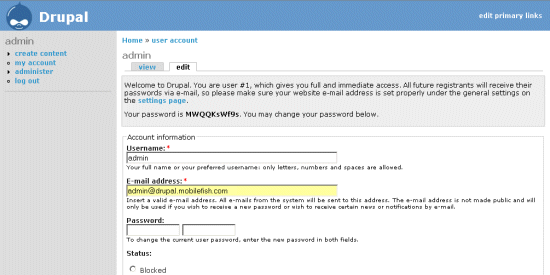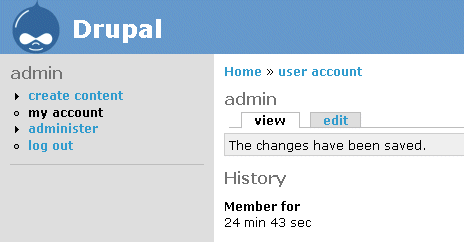Drupal is a is database driven (MySQL and PostgreSQL) content management
system, which supports pluggable modules that enable additional behaviors.
It is considered to be an excellent platform for developers due to its clean code and
extensibility, and it can also be used as a Web application framework.
The modules available for Drupal provide a wide assortment of features, for example:
- locale support
- workflow
- theme support
- content rating
- taxonomy support
- mailing list management
- error logging
- discussion forums
- photo galleries
- web based administration
- user management
- content versioning
- page caching for high performance websites
More information about Drupal can be found at:
http://drupal.org
The latest Drupal version can be downloaded from:
http://drupal.org/project
Drupal forum can be found at:
http://drupal.org/forum
Installing Drupal 4.7.0
Information
Overview of Drupal 4.7.0 requirements:
|
|
Operating system
|
- Windows (95/98/2000/2003/ME/NT/XP)
- Linux
- Sun Solaris
- HP-UX
|
|
Web server
|
- Apache (1.3.0 or higher) or (2.0 or higher)
- MS Internet Information Server (5.0 or higher)
|
|
PHP
|
- 4.3.3 or greater
- 5.0 or greater
|
|
Database
|
- MySQL (3.23.17 or higher)
- Postgres (7.3 or higher)
|
Operating system used
Windows XP Home Edition Version 5.1 SP 2
Software prerequisites
Apache 1.3 or higher.
MySQL 3.23.55 or higher.
PHP 4.3.3 or higher or PHP 5.
Procedure
- Download and unzip drupal-4.7.0.tar.gz.
For example: C:\drupal-4.7.0
Note:
The size of the zipped file is 473 KB and unzipped it is 1,65 MB.
- Rename the directory, for example: C:\mobilefish_drupal
- Update the C:\Tools\Apache Group\Apache2\conf\httpd.conf file.
Add the following lines below the httpd.conf file:
<VirtualHost 192.168.1.100:80>
ServerAdmin [email protected]
DocumentRoot c:/mobilefish_drupal
ServerName drupal.mobilefish.com
ErrorLog logs/drupal.mobilefish.com-error_log
#TransferLog logs/drupal.mobilefish.com-access_log
#CustomLog "|c:/weblogs/rotatelogs.exe
c:/weblogs/drupal.mobilefish.com-access_%y%m%d.log 86400" combined
<Directory "c:/mobilefish_drupal">
Options +Includes
AddType text/html shtm
AddOutputFilter Includes shtm
AllowOverride All
</Directory>
</VirtualHost>
See an example of an httpd.conf file.
Note: AllowOverride All needs to be set if you want to display clean URLs.
Instead of the following URL http://drupal.mobilefish.com/?q=admin you will see:
http://drupal.mobilefish.com/admin
Admin | administer | settings: Enable Clean URLs
- Update the C:\WINDOWS\system32\drivers\etc\hosts file.
Add the following line:
127.0.0.1 drupal.mobilefish.com
- Start MySQL
- Create the Drupal database:
C:\Tools\mysql\bin>mysqladmin -uroot -pmysecret create drupal
where:
username = root
password = mysecret
database = drupal
-
Start the command line MySQL monitor:
C:\Tools\mysql\bin>mysql -uroot -pmysecret
You should see:
Welcome to the MySQL monitor. Commands end with ; or \g.
Your MySQL connection id is 8 to server version: 4.0.18-nt
Type 'help;' or '\h' for help. Type '\c' to clear the buffer.
mysql>
- The database user (in our example "root") must have all of the privileges listed below,
if not you will not be able to run Drupal.
mysql> GRANT SELECT, INSERT, UPDATE, DELETE, CREATE, DROP, INDEX, ALTER, CREATE
TEMPORARY TABLES, LOCK TABLES ON drupal.* TO root@localhost;
where:
username = root
database = drupal
You should see:
Query OK, 0 rows affected (0.00 sec)
- To activate the new permissions, enter the following command:
mysql> FLUSH PRIVILEGES;
You should see:
Query OK, 0 rows affected (0.00 sec)
- Exit the MySQL monitor, enter the following command:
mysql> quit;
You should see:
Bye
- Load the Drupal database schema:
C:\Tools\mysql\bin>mysql -uroot -pmysecret drupal < C:\mobilefish_drupal\database\database.4.0.mysql
where:
username = root
password = mysecret
database = drupal
Note:
Depending on the version of MySQL you are using, you must use the
file "database.4.0.mysql" (for MySQL 4.0 or lower) or "database.4.1.mysql"
(for MySQL 4.1 or higher). Both files are located in Drupal's database directory.
- Update file C:\mobilefish_drupal\sites\default\settings.php
and change the database connection:
$db_url = 'mysql://root:mysecret@localhost/drupal';
where:
username = root
password = mysecret
host = localhost
database = drupal
- Set $base_url to match the address to your Drupal site:
$base_url = 'http://drupal.mobilefish.com';
Note: Never add a forward slash at the end.
- Create subdirectory: C:\mobilefish_drupal\files
This subdirectory stores files such as
custom logos, user avatars, and other media associated with your
new site. The sub-directory requires "read and write" permission.
- (Re)start Apache.
- You can now launch your browser and point it to your Drupal site.
Type in browser:
http://drupal.mobilefish.com
- Click the link "Create new account" on the left hand side.

- Create an new account. For example enter:
Username = admin
Email address = [email protected]

Click button "Create new account".
- This first account will automatically become the main administrator account with total control.

- Change the password, e.g.: mydrupalsecret and press submit button.
- The change is saved.

|
|



